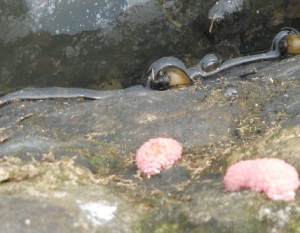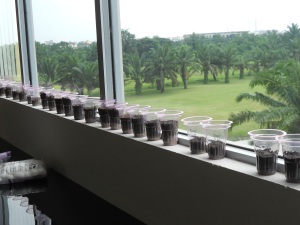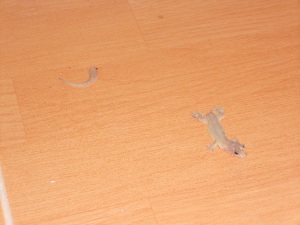Lab-ventures!
These pictures and stories are being disseminated slowly over emails and on Facebook, so if you’ve heard them already (in these exact words, even!) I apologise. However, I thought it’d be nice to have them collected in on place, and I also thought I’d write a bit more in depth over here. These are some of the adventures we’ve had in science classes over the past couple of weeks. Because… (wait for it!) …
The laboratory is finally functional! Mostly. We don’t have gas yet (if I’m being perfectly frank, I’m a little nervous of them turning it on) and that could be slightly problematic for the Bunsen burner lessons we are supposed to begin next week;  but we have a great space to work in and the students are really getting a kick out of trekking up to the 4th floor for science. It’s like a mini-field trip twice a week — I walk into the P5 classroom and am greeted with, “Miss, today we can go to the lab?” in earnest tones.
but we have a great space to work in and the students are really getting a kick out of trekking up to the 4th floor for science. It’s like a mini-field trip twice a week — I walk into the P5 classroom and am greeted with, “Miss, today we can go to the lab?” in earnest tones.
Speaking of mini-field trips: there is a golf course behind the school (I may have mentioned this) that has a largish pond, and we have an standing invitation from said golf course to go and tromp about in it. So, for Monday I made plans to take the Year 7’s out to collect aquatic plants as part of our exploration of plant adaptations. This announcement was greeted with cheers and great big smiles, so we happily and excitedly trotted out of the school to go wandering amidst the rough. We found all sorts of interesting things out there, not least of which were the peculiarly beautiful clusters of what we think were dragonfly eggs, pink and perfectly spherical and adorning the water-weeds by the dozens in huddled little conglomerations. The boys went at collecting with a will, while the girls mostly stood well away from the mud and pointed at interesting things; but after a bit, the draw of good old-fashioned dirt had even the most fastidious of the girls down amongst the buttercups and pondweeds. The first time I suggested we go back inside, I was rapidly shot down in favor of exploring the opposite bank, which took a bit of pathfinding to get to but was completely worth our time for several other (obviously cultivated) varieties of plants, as well as some snails, earthworms, and other creepy-crawlies. Well-satisfied with our bounty, and a little bit hot and sticky, we returned to the lab to make observations and (thoroughly scientific) drawings — and rounded out the day with a game of Pond Bingo.
We found all sorts of interesting things out there, not least of which were the peculiarly beautiful clusters of what we think were dragonfly eggs, pink and perfectly spherical and adorning the water-weeds by the dozens in huddled little conglomerations. The boys went at collecting with a will, while the girls mostly stood well away from the mud and pointed at interesting things; but after a bit, the draw of good old-fashioned dirt had even the most fastidious of the girls down amongst the buttercups and pondweeds. The first time I suggested we go back inside, I was rapidly shot down in favor of exploring the opposite bank, which took a bit of pathfinding to get to but was completely worth our time for several other (obviously cultivated) varieties of plants, as well as some snails, earthworms, and other creepy-crawlies. Well-satisfied with our bounty, and a little bit hot and sticky, we returned to the lab to make observations and (thoroughly scientific) drawings — and rounded out the day with a game of Pond Bingo.
This term the Primary 6 class has been studying the reproduction of plants. In that spirit, our first few labs have been about the differences between plants that germinate from seeds, and plants that reproduce asexually.  Our first attempt at growing bean seeds ended with a bit of a disaster — the experiment setup called for using damp cotton wool to grow the beans; as it turns out, that might be all well and good in a temperate climate, but in our bean jars we had an impressively prodigious mold growth. (This inspired a spontaneous 15-minute lesson on Alexander Fleming’s discovery of penicillin, and, by not-so-obvious but deftly-led extension, the invention of velcro.) So we scrapped the original design, and made cups-o-soil for our beans as well as for small onion bulbs and potato eyes.Getting all that soil everywhere was more than worth it when the kids came into class today to find that many of their onion bulbs had completely taken over the cups in just two days.
Our first attempt at growing bean seeds ended with a bit of a disaster — the experiment setup called for using damp cotton wool to grow the beans; as it turns out, that might be all well and good in a temperate climate, but in our bean jars we had an impressively prodigious mold growth. (This inspired a spontaneous 15-minute lesson on Alexander Fleming’s discovery of penicillin, and, by not-so-obvious but deftly-led extension, the invention of velcro.) So we scrapped the original design, and made cups-o-soil for our beans as well as for small onion bulbs and potato eyes.Getting all that soil everywhere was more than worth it when the kids came into class today to find that many of their onion bulbs had completely taken over the cups in just two days.
The P6’s had one of those “Gross! Cool!” moments this afternoon in class – yeah, you know the one. Like finding a smashed frog on the side of the road, or (thanks, Lisa and Diana) watching wasp larvae crawl out of a caterpillar. In the middle of our lesson this afternoon, we heard a strange thunking sound coming from the air-conditioner. As is my usual practice, I turned around to make a face at it (I make faces at inanimate objects a lot because it never fails to crack my students up) just in time to watch something pretty large come flying through the air, making a “thud” as it hit the ground.
Now, lately we’ve been having a problem with insects getting into the air ducts and flying out of the air conditioners on that end of the building, so I was fully expecting a moth or possibly a beetle or something similar to have come careening out. Instead, I tromped over to the unit and there, beneath the air-conditioner, was a severed gecko tail twitching madly, its poor undignified (and obviously dead) body lying nearby with its tongue sticking out.
Naturally, this incurred the requisite “Ewww!!”s and “Whoa!!”s from the P6s. It also, serendipitously, served extremely well to illustrate a point I had actually been making not 10 minutes earlier in the lesson about animal defenses, and how some adaptations are passive rather than active (having poisonous skin rather than spitting poison, etc). There is nothing so passive as a thoroughly dead gecko. I think the kids got the point.
Y7 starts acids and bases next week; P6 is moving into changes of matter and P5 is going to be doing some electroplating, so I hope to have more fun adventures to share with you then. Cross your fingers that our lab survives the advent of the gas canisters, and the maiden voyages of the Bunsen burners…
Posted on October 20, 2011, in Uncategorized. Bookmark the permalink. 2 Comments.
ive always wanted to see a gecko lose its tail!
Come to Indonesia. We’ll catch a dozen in my kitchen. (No kidding.)